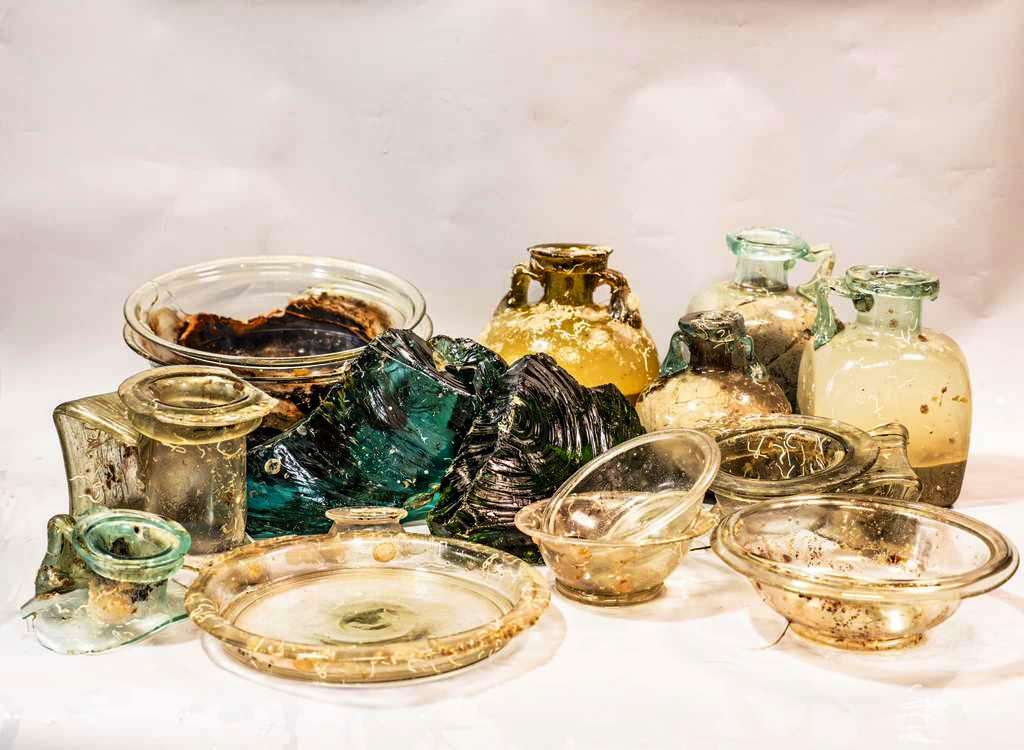A glass-laden Roman wreck, a rarity in Corsican waters
A 2,000-year-old Roman ship, probably departed from what is now Lebanon and headed for Provence, sank between Corsica and the shores of the beautiful island of Capraia. And at a depth of just 350 meters a wreck has been discovered, which since early July has been the site of investigation by a French-Italian expedition tasked with sounding the bottom and bringing the cargo to the surface. The importance of the discovery lies in the contents of the cargo: tons of glass in both raw and forged state in pottery, plates, bottles, cups and bowls, jugs, amphorae (“carrot” amphorae, oriental amphorae including probable Beirut-type amphorae and a few Gauloise 4 amphorae) and two bronze basins. This is the second known case to date in the Mediterranean Sea of a Roman shipwreck with a cargo consisting almost exclusively of glass.
The research team on the wreck, dubbed “Cap Corse 2,” consists of a bilateral mission of the French and Italian governments, coordinated by the latter through the National Superintendence for Underwater Cultural Heritage of the Ministry of Culture. France is providing human and technological resources from the Département des Recherches Archéologiques Subaquatiques et Sous-marine (Drassm) of their counterpart department with the collaboration of archaeologist Souen Fontaine a specialist in ancient glass. And for the first time archaeological research has been combined with marine biological observation of the fauna of these particular deep-sea ecosystems thanks to the direct participation of ecologist Nadine Le Bris (Sorbonne Université-Museum National d’Histoire Naturelle), while Carlotta Sacco Perasso will be in charge of deep-sea biological colonization on the archaeological artifacts of the cargo, indicated by the Italian National Superintendency.
A mission that should therefore bring several results also because of the size of the finds and their state of preservation by going to answer questions about the maritime trade of that time and with the opportunity to deepen research on marine flora and fauna without mentioning the new technologies and systems that for the occasion will be tested for this type of operations. For the conduct of deep-sea research, in fact, the Drassm has made available its flagship research vessel, the Alfred Merlin, equipped with its two ROVs (remotely operated underwater vehicles) Arthur and Hilarion. Arthur, is a new prototype ROV designed and created with and for Drassm by Professor Vincent Creuze (University of Montpellier-LIRM), who actively participated in the mission. This robot, one of the smallest and lightest in its class, can reach 2,500 meters and allows not only to take high-definition video footage but also to ventilate or vacuum sediment and retrieve objects. The Rov Hilarion, piloted by archaeologist Denis Degez (Drassm) takes high-definition video up to a depth of 500 m.
The first week of joint Italian-French work has excited the researchers, who are already thinking about the next session of joint work on the wreck hoping to broaden the spectrum of fields of investigation. All archaeological materials will be transported to the laboratory of the National Superintendency in Taranto for scientific analysis, characterization of biological degradation and restoration. The crystal clear water of Capraia Island with its marine flora and fauna will also be a glimpse of the richness of the marine ecosystem here at the highest levels of biodiversity not “disturbed” by man.
The collaboration program was launched in 2022, after the creation of the Italian National Superintendency, and the signing of the scientific agreement between the Drassm, headed by Arnaud Schaumasse, and the National Superintendency in April 2023. The discovery, dating back to 2012, is due to engineer Guido Gay who reported it to the authorities, as a good citizen. And as the law requires.
 |
| A glass-laden Roman wreck, a rarity in Corsican waters |
Warning: the translation into English of the original Italian article was created using automatic tools. We undertake to review all articles, but we do not guarantee the total absence of inaccuracies in the translation due to the program. You can find the original by clicking on the ITA button. If you find any mistake,please contact us.





























